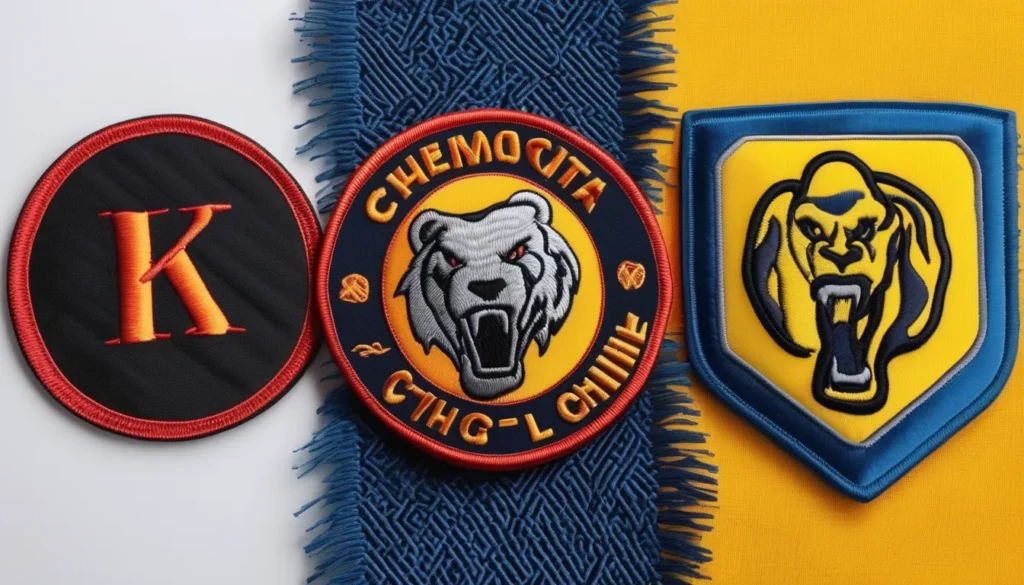
Choosing the right custom patch type can be a game-changer, whether you’re designing patches for uniforms, personal clothing, or team gear. Among the most popular types—embroidered, PVC, and chenille patches—each has unique qualities and fits different needs. In this guide, we’ll explore the features, advantages, and ideal uses of each patch type to help you make the right choice.
- Understanding Patch Types: A Brief Overview
With many patch options on the market, it can be overwhelming to choose the right one. Embroidered patches are a classic choice with a timeless, textured look. PVC patches bring a modern, durable option ideal for rough conditions. Chenille patches, with their soft and fuzzy appearance, are a favorite for sports and fashion. Each patch type offers distinct benefits, so finding the right one depends on where and how you’ll use it.
- Embroidered Patches
Description and Appearance
Embroidered patches are created by stitching thread onto a fabric base. This classic patch type has a textured, stitched look that gives off a traditional, high-quality feel. They’re often seen on uniforms, jackets, and sports team apparel, providing a sense of class and professionalism.
Best Uses
Embroidered patches are ideal for uniforms, team logos, and vintage-style designs. They’re a go-to for schools, organizations, and anyone looking for a traditional aesthetic. These patches give a high-quality, polished look that’s recognizable and timeless.
Pros and Cons
- Pros: Embroidered patches bring a classic, high-quality appearance that many people appreciate. They’re durable and can handle regular wear on clothing items like uniforms and jackets.
- Cons: While embroidered patches are detailed, they have limitations. Highly intricate designs may not come out as clearly due to the stitching process. Additionally, if exposed to lots of wear or washing, the edges can sometimes fray over time.
- PVC Patches
Description and Appearance
PVC patches are crafted from soft plastic, giving them a durable, waterproof quality. These patches are vibrant and can be made with 3D designs, providing a bold, modern look. Unlike fabric patches, PVC patches are smooth to the touch and resistant to fading or damage from water and sunlight.
Best Uses
PVC patches work well on outdoor gear, tactical items, and products that need to withstand tough conditions. They’re popular on bags, hats, and jackets that are used for outdoor activities or rugged environments.
Pros and Cons
- Pros: PVC patches are waterproof, resistant to fraying, and able to withstand a lot of wear. They’re perfect for people looking for durable patches that maintain their look over time, even in tough environments.
- Cons: Some people find PVC patches to be heavier than other types, and they lack the traditional, textured look of embroidered or chenille patches. For those looking for a classic appearance, PVC may not be the best choice.
- Chenille Patches
Description and Appearance
Chenille patches are made with yarn, resulting in a fuzzy, wool-like texture. They have a soft, plush appearance that’s eye-catching and often associated with letterman jackets and varsity logos. This patch type is particularly known for its unique, retro look.
Best Uses
Chenille patches are great for fashion, sports teams, and statement pieces. They’re commonly seen on letterman jackets, high school logos, and other athletic wear. They bring a unique, soft texture that stands out on clothing.
Pros and Cons
- Pros: The soft texture of chenille patches makes them lightweight and unique, perfect for sports or fashion items that want to make a visual impact.
- Cons: Chenille patches are less durable than PVC patches and aren’t ideal for very intricate designs. Their fuzzy surface can wear out over time, especially with regular washing.
- Comparing Key Factors: Durability, Detail, and Aesthetic Appeal
Durability
PVC patches are the most durable, followed by embroidered patches, which are sturdy but can fray over time. Chenille patches are the least durable since their texture can wear down with use.
Detail and Texture
For intricate details, PVC patches are excellent as they can capture designs with precision. Embroidered patches offer good detail but have some limitations with extremely fine designs. Chenille patches, while visually striking, don’t suit highly detailed work and are better for bold, simple shapes.
Aesthetic Appeal
For a timeless, classic look, embroidered patches are best. PVC patches bring a bold, modern touch, and chenille patches are ideal for retro, textured fashion statements.
- Choosing the Right Patch for Your Needs
For Uniforms and Professional Use
If you need patches for uniforms, team apparel, or professional settings, embroidered patches are usually the best choice. They offer a polished, sophisticated look and give off a sense of tradition and quality.
For Outdoor and Heavy-Duty Use
PVC patches are perfect for outdoor gear and any items exposed to tough conditions. If durability is your priority, PVC patches will withstand weather, rough handling, and repeated use without losing their appearance.
For Fashion and Statement Pieces
Chenille patches add a bold, fashionable look to clothing, especially for sports teams, school logos, or varsity jackets. They’re a good choice for statement pieces where durability is less important than style.
- Conclusion: Finding the Best Fit for Your Project
When it comes to choosing the right patch type, consider both functionality and style. Embroidered patches offer a classic, refined look, PVC patches provide unbeatable durability, and chenille patches deliver a soft, vintage appeal. By understanding the unique benefits of each type, you can find the perfect patch to fit your needs and make your design vision a reality. Whether you’re creating patches for a sports team, professional uniforms, or fashion items, selecting the right material ensures that your patches look great and last as long as you need them to.



